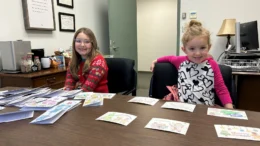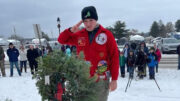It’s almost inevitable.
Chances are this Christmas season that someone – maybe even you – will give your children or grandchildren an electronic gift of some kind. And they’ll most likely love it.
But it will, more often than not, keep them inside.
That’s OK, to a point.
However, if you love being outdoors and hope to pass along that passion to the next generation, you’ve got to make a point of getting them on the other side of their own four walls, too.
So here are five ways to get children outside this winter.
Look for animal tracks
A walk in the woods is fun. A walk in the woods that examines what else has been there already is even better.
And winter is a great time for tracking.
The hard-packed, dry earth of summer is gone. In its place is snow or mud resulting from winter rains.
Both make tracks obvious.
You don’t necessarily have to go far to get started either. If you frequently see squirrels or rabbits in the back yard, for example, look around brushes and trees after a snow for tracks.
But if you want to wander farther afield, visit a local park. If a creek flows through it, check its banks.
They can be especially fruitful.
And if you want to bring some of this fun back indoors, download the Ranger Rick “Tangled Tracks” pattern. With that you can make your own wildlife-themed Twister game.
Kids not only get some exercise indoors, without a screen, but can compare the tracks they see outside to what’s on the game.
Make tree rubbings
Trees don’t leave tracks like animals, of course. But they have their own distinctive features.
Their leaves are obvious. But they’re gone, or mostly so, by now.
Not to worry. Their bark is as tell-tale as anything. That of an oak, for example, is far different from that of a birch.
A fun way to teach kids one tree from another is to do bark rubbings in winter.
Head into the woods with white paper – tracing paper works best – and a box of crayons. Hold the paper tight against a tree and have your child rub a crayon, held sideways so as not to poke through the paper, across it until a pattern appears.
Bigger trees work better than smaller ones, as the bark is usually more defined the older a tree gets.
Use different colors on different trees.
When you’re done, take those rubbings back home and compare them to what you see in a tree identification book (or even pictures from the Internet).
Either way, you’ll have spent time outdoors, and you’ll be bringing some of that back inside for more fun.
Feed birds
Not all birds migrate south for the winter. Many remain throughout winter, when finding enough food to sustain themselves is a constant challenge.
Help them, and have some fun with your kids, by feeding them throughout the winter.
That can be as simple as putting up a feeder full of seed and watching through a window to see what shows up, of course.
But a better way to get the kids hooked on this activity is to be creative in making feeders.
One thing you can do is make a Christmas tree-like garland by stringing a line of popcorn, bits of dried fruit and even sometimes bigger seeds or nuts together. Hung around a tree, that draws birds.
So, too, does a bagel cut in half or a pine cone. Slather either with peanut butter and seeds and hang them from a tree.
Or think seasonal. When making Christmas cookies, use your cutters to make stars, snowmen, trees and more out of slices of bread. Let those sit for a day or two to get stale, then cover them with peanut butter and seeds and hang them, too.
Just remember, if you start feeding birds, plan to continue throughout the winter. You don’t want to condition the birds to visiting a food source and then pull it away.
Color wildlife
Coloring books themed around wildlife are great tools for developing an interest in the outdoors if used correctly.
And there are some really good – and free – ones available online. The Pennsylvania Game Commission offers a 60-pager that features all kinds of critters, from white-tailed deer to meadowlarks. It groups animals by habitat, too, showing, for example, which lives in forests and which live in farms.
It also features vocabulary words, animal tracks – kids can compare the size of their footprint to a black bear’s – and more.
Pennsylvania’s state park system also has a coloring book that includes a word search and a bit of advice on keeping parks healthy and clean.
Many state wildlife agencies offer the same. West Virginia’s Division of Wildlife has “critter coloring sheets” for mammals, birds, reptiles and amphibians.
Here’s the key, though. Don’t just give the kids a few sheets and box of crayons and turn them loose.
Let them color, then put them on your lap and talk about the animals they just colored. Go over where they live, where and when you’ve seen one, what they’re like.
Afterward, go for a hike, exploring farm country or a woodlot to look for the animals they colored.
Your interest can be contagious.
Build a nest box
A lot of wildlife species are what’s known as “cavity nesters.” That means they live in nature’s nooks and crannies, like old hollow trees.
But bluebirds, wood ducks, squirrels, barred owls, American kestrels and others will also make ready use of manmade structures that offer the same protections. That’s where nest boxes come in.
As with the coloring books, free plans are available all over the web. Ohio’s Division of Wildlife has a handy booklet you can download full of plans. So, too, does the Game Commission.
Others, like Louisiana’s Department of Wildlife and Fisheries, not only provide plans, but offer information on where to place nest boxes, what predators to be on the lookout for and how to maintain boxes season to season so they keep drawing wildlife.
Most of the plans are pretty simple. Anyone with a hand saw, a drill and a hammer can make most.
Then the fun starts. Make sure the kids are involved in the hammering – inevitable bent nails and all – and the hanging and the monitoring.
There’s plenty of opportunity all the way through to talk about wildlife, it needs, its challenges and more. And then you get to go outside, place the box and watch it.
Monitoring it can become a year-round activity. You can even keep a log from season to season to note what uses your boxes and when and if anything changes.
So go ahead, let the kids unwrap those techy gadgets.
But don’t give in completely. Make sure to build some outdoors adventure into their lives, too.
Bob Frye is the Everybody Adventures editor. Reach him at (412) 216-0193 or bfrye@535mediallc.com. See other stories, blogs, videos and more at EverybodyAdventures.com.
































